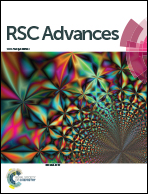Fabrication and characterization of novel lignocellulosic biomass tailored Fe3O4 nanocomposites: influence of annealing temperature and chlorazol black E sequestration†
Abstract
This study discusses the prospect of using a waste biomass material in the development of novel technological materials for sustainable environmental applications. Novel iron oxide nanocomposites (IONCs) were fabricated using a waste lignocellulosic biomass (LB) material (papaya leaves) by employing the chemical precipitation technique. The IONCs were subjected to annealing temperatures of 353, 573, and 773 K, and precursor ratios of 1 : 1 and 2 : 1. The nanocomposites were characterized by FTIR, XRD, TEM, SAED, EDX, CHN(O), N2 adsorption, and VSM analyses. An increase in annealing temperature of the LB–IONCs resulted in larger particle size, better crystallinity, and improved magnetic properties. LB–IONCs annealed at 773 K were found to be the most effective material (among its counterparts) for the removal of chlorazol black E, with an efficiency of 96.45% and a monolayer sequestration capacity of 40.02 mg g−1. Hydrogen bonding and π–π dispersive interactions governed the sequestration mechanism.


 Please wait while we load your content...
Please wait while we load your content...